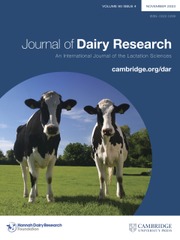No CrossRef data available.
Article contents
Heifers introduced a new subtype into a herd with persistent Staphylococcus aureus intramammary infections
Published online by Cambridge University Press: 19 May 2025
Abstract
This study describes the spread of intramammary infections (IMI) during the first lactation of heifers that were naturally infected with Staphylococcus aureus before parturition and introduced into a herd with a high prevalence of this organism. The heifers were monitored during their first lactation to determine potential spread and persistence of IMI and to characterize the isolates that caused IMI. Milk samples were obtained from all the cows in the lactating herd at the beginning of the study and one year later. S. aureus isolated at both these sampling times were compared with those obtained from the heifers to analyse their clonal and phylogenetic relationships, employing pulse-field gel electrophoresis (PFGE), multi-locus sequence typing and Fourier transform infrared spectroscopy. Most S. aureus isolated from mammary secretions of heifers before parturition established chronic IMI during the first lactation. PFGE typing discriminated 3 clusters that were associated with origin of isolates, number of lactations and clonal complex. Differences both in the presence and expression of genes associated with virulence determinants among the major pulsotypes infecting lactating cows and those from heifers that developed persistent IMI were detected, which are indicative of distinct adaptive capacities to generate IMI.
Information
- Type
- Research Article
- Information
- Copyright
- Copyright © The Author(s), 2025. Published by Cambridge University Press on behalf of Hannah Dairy Research Foundation

